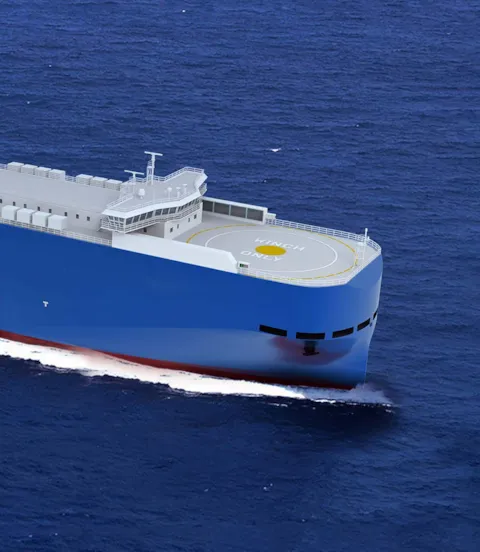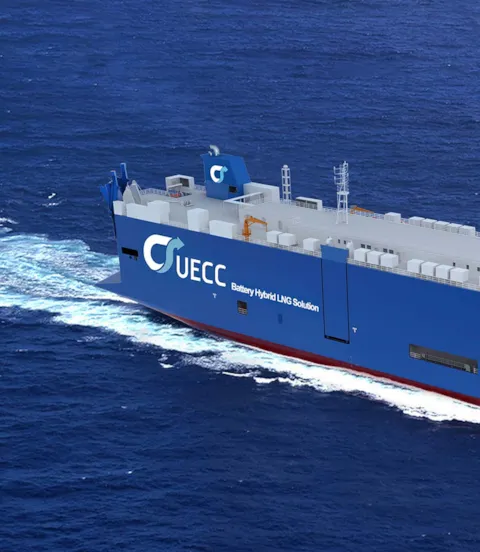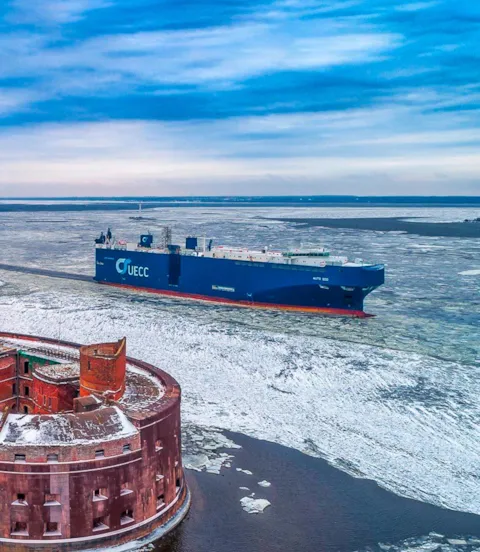UECC doubles down on LNG
UECC has ordered its second pair of dual-fuel LNG PCTC vessels based on their positive experience with the first two, in operation now for nearly four years. The new twins will add battery hybrid technology to the already eco-friendly design package.
“For us there was never any doubt that dual-fuel LNG was the best solution for our trade in the Baltic,” says UECC CEO Glenn Edvardsen. “Environmental compliance was the first criteria, to be able to sail freely in ECAs where we mainly operate. But the economics of running on LNG have proven to be even more favourable than we had counted on. This has made LNG a good choice for us on both fronts.”

Evaluating the environmental options
Optimal hull design was another measure to reduce the environmental footprint, by contributing to improved fuel efficiency. For example, the ECO-series ships have no conventional bow bulb. “Bulbs work best at design draft and speed,” says Vegar Rype, Key Account Manager, Business Development, North Europe in DNV GL. “But a fore-ship without a pronounced bulb may be beneficial if trim or local draft variations are to be expected, as is the case with UECC’s Baltic trade. A no-bulb concept design has a sharper waterline at various drafts for better performance in waves.”
DNV GL supported UECC in identifying and evaluating different design options, including the dual-fuel solution. “Dual-fuel technology gives us flexibility. We can also switch to alternative carbon-neutral or synthetic fuels should they become attractive,” Edvardsen confirms.
He notes the importance of having a qualified sparring partner on the design team. “A ship is a significant and longterm investment. We needed to be able to get our assumptions and preferences verified. LNG is not new, but it’s not old either, and we needed outside expertise. DNV GL has in-depth knowledge going back to the start of marine LNG, and with their support, we now feel that we have good competence on LNG as fuel.”
The new vessels will meet the IMO Tier 3 NOX emission limitations entering into force in the Baltic and North Sea from 2021 keel lays. “Our solution will also take us beyond the IMO target of 40 per cent reduction in carbon intensity by 2030,” Edvardsen says.
LNG is not new, but it’s not old either, and we needed outside expertise. DNV GL has in-depth knowledge going back to the start of marine LNG, and with their support, we now feel that we have good competence on LNG as fuel.

LNG on the rise
Though LNG infrastructure is currently being developed at a rapid pace, especially in Northern Europe, that was not always the case. “We managed to get commitments to developing infrastructure early on in the planning process by agreeing to the first two ships,” Edvardsen says. “You might say we solved the chicken and egg problem. It was a ‘We’ll build if you will’ kind of arrangement with the developers.”
Nonetheless, he confirms, UECC was always confident that LNG would grow in popularity and expand its footprint, and that has proved to be the case. “The EU has been a supporter of LNG infrastructure development, which has put Europe ahead of many other places in the world. The infrastructure is growing and will continue to grow,” Edvardsen believes.

Electric power saves fuel and reduces emissions
One notable feature separating the first pair of newbuilds from the second is battery hybrid power. “Batteries are a part of the development to next generation power,” Edvardsen observes. “We wanted to move things forward to the next step.” The main benefits of battery power on the new ships are improved operational efficiency and reduced emissions, he says. “This helps put us on track to meet the IMO 2030 requirements. It also provides an option for reducing emissions while in port, and that is becoming more important for many cities.”
The ships will be shore power ready as well. “Many ports will have shore power soon. The EU will have an influence in the spread of shore power, and they will weigh the investments from shipowners in their considerations of support to ports.”
In that way, Edvardsen says, UECC can influence EU investments through providing ships that are ready to use the system. “For us shore power is a natural path to follow, and we are doing our part to move the process along.

Uncertainty dominates newbuild picture
For all the enthusiasm in UECC for new technologies in new PCTCs, why does Glenn Edvardsen believe there are so few newbuilding orders in the segment? “I think uncertainty explains a lot,” he says. “Environmental regulations are tightening, but the technology is not always there to provide the answers.”
Fuel choice will be a factor as well, he says. “Many owners are waiting to see which fuels become the most viable. It’s easy to make a wrong choice, so owners are cautious.” Freight rates are low too, he points out, so owners are reluctant to take the chance of being first to chose a new technology.
“The point for us is to gain a competitive edge while meeting our responsibilities. The environment is a major factor, and we have to make choices and move forward with measures that make a difference. Our choices have allowed us to exceed current requirements, and we feel certain that we will be able to meet or exceed future requirements as well.”

Vegar Rype
Key Account Manager
- Key image: UECC
- Side image 2: UECC
- Text image: UECC
- Side image 3: UECC

